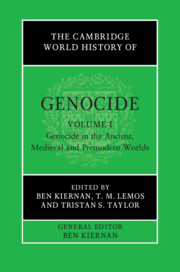Book contents
- The Cambridge World History of Genocide
- The Cambridge World History of Genocide
- The Cambridge World History of Genocide
- Copyright page
- Contents
- Figures
- Maps
- Tables
- Contributors to Volume I
- General Editor’s Acknowledgements
- General Editor’s Introduction to the Series
- Introduction to Volume I
- Part I Themes of Genocide through History
- Part II The Ancient World
- Part III The Medieval World and Early Imperial Expansions
- Index
General Editor’s Introduction to the Series
Genocide: Its Causes, Components, Connections and Continuing Challenges
Published online by Cambridge University Press: 23 June 2023
- The Cambridge World History of Genocide
- The Cambridge World History of Genocide
- The Cambridge World History of Genocide
- Copyright page
- Contents
- Figures
- Maps
- Tables
- Contributors to Volume I
- General Editor’s Acknowledgements
- General Editor’s Introduction to the Series
- Introduction to Volume I
- Part I Themes of Genocide through History
- Part II The Ancient World
- Part III The Medieval World and Early Imperial Expansions
- Index
Summary
Genocide has a way of imposing silence. Part of its purpose is to erase history, and human voices. This series of three volumes aims to contribute to breaking the silence that so often follows genocidal outbreaks. These volumes attempt to document and understand this global phenomenon. The term “genocide,” as a way of describing the “practice of extermination of nations and ethnic groups,” was coined in 1943, when Raphael Lemkin (1900-1959) penned the preface to his 1944 book Axis Rule in Occupied Europe. Five years later the United Nations General Assembly unanimously adopted the Genocide Convention. But Lemkin considered genocide to have much older roots. He had set about writing – but did not complete before his death – a three-volume history of genocide from ancient times, in which he argued that the phenomenon had “followed humanity throughout history.”
Keywords
- Type
- Chapter
- Information
- The Cambridge World History of Genocide , pp. 1 - 30Publisher: Cambridge University PressPrint publication year: 2023

